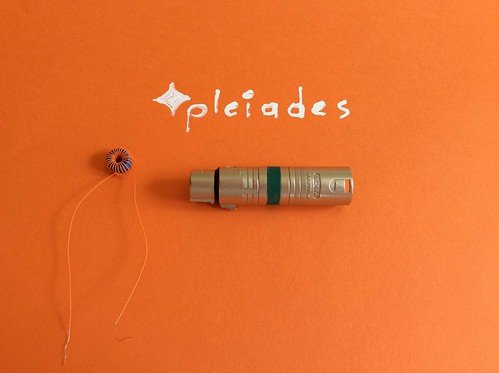The Pleiades V6 will possibly be the most revealing and lowest noise microphone electron tube preamplifier on the planet.
It will have 2 channels for stereo or binaural and it will be powered by just one 3.7V lithium ion battery for both tubes including anodes. The anode voltage will be close to 3.7V. It may be said that the preamplifier is a modified H. D. Arnold amplifier for operation with very low anode voltage.
For each channel:
The electron tube to amplify the microphone signal will be the EF183 vari mu pentode connected as triode, i.e. screen grid, suppressor grid and anode connected together. Actually the screen grid does most of the job of collecting electrons as it is nearer to the cathode.
It will employ the fewest components possible for the simplest signal path, close to wire with gain.
Each channel will only have 6 components.
The signal path will be as follows:
Input transformer - coupling capacitor - EF183 electron tube - high MΩ resistor from anode to control grid - output transformer - 3.7V rechargeable battery
Description of each component:
The input transformer shall be made with Magnetec Nanocrystalinne toroidal core. This will permit the fewest possible turns for low noise. The primary inductance will be chosen to compensate for the proximity effect so that many world class dynamic microphones or not can be sung too at a typical distance of 4in with flat ear-brain frequency response and pristine quality. The step up ratio may be of the order of 1:20 for great sensitivity and very low noise.
The coupling capacitor will isolate the electron tube grid from the low resistance of the secondary winding. So the grid will be free to assume its potential from the surrounding charge conditions. The value of the capacitor will be chosen in consideration to the input impedance of the tube which may be of the order of 100K, see tube description.
The high resistor from anode (plate) to grid will take care of the neutralization of the negative charge on grid induced from surrounding electrons and cathode emission traffic electrons (boiling electrons ;). It will make possible the free travel of electrons to anode with just 3.7 volts and will be named Rgh in honor of Hliana for bringing to light the knowledge of the importance of the grid bring positively biased to make electrons free.
The EF183 electron tube triode connected will exhibit an input impedance of the order of 100KΩ depending on the value of the high Megohm Rgh resistor chosen for optimum behaviour. The lower than usual input impedance may prove usuful in damping any reasonance effect of the input transformer. The cathode will be connected to negative ground, no cathode resistor needed this further avoiding the need of a bypass electrolytic capacitor.
The output transformer will be made of a larger Magnetec, Nanocrystalinne toroidal core. The primary will be connected directly to the anode as is done on the Western Ekectric 47 condenser capsule amplifier. This will avoid thermal resistance noise of any anode resistor and no voltage drop. So the anode will be very near to 3.7 volts as the other side of the primary will be connected to the positive 3.7V.
The heater will also be connected directly to the 3.7 volt battery. The cathode will be underheated operating as is done on the WE 47 and the Neumann U47 at a temperature of the order of 700oC. Aklowledgement to Oliver Archut of Tab Funkenwerk for publishing his measurements of cathode temperatures on his WE 47 article. The low temperature will further increase the sensitivity of the electron tube and further reduce noise. An explanation may be that at such low signals very few electrons are needed to carry the information to anode. If the tube is heated at specified 6.3V the electron trafic around the cathode and near grid will be tremendous and unessasary. It has also been experimentally measured by a 10MΩ Zin voltmeter that it causes the grid to be biased negatively by induction, or in other words the cathode is positive due to the missing electrons that have escaped (see older euroelectron posts).
Inputs and outputs as described above will be low impedance and balanced. So the Pleiades V6 can be connected to any microphone be it ribbon, dynamic, or condenser. The output of the Pleiades V6 will feed the input of any microphone preamplifier in the same manner as a U47 microphone does with its internal preamplifier connected to any microphone input.
A fuse may be needed in series will the battery. A resistor may be experimentally chosen in series with the heater circuit for optimum cathode temperature for maximum sensitivity.
